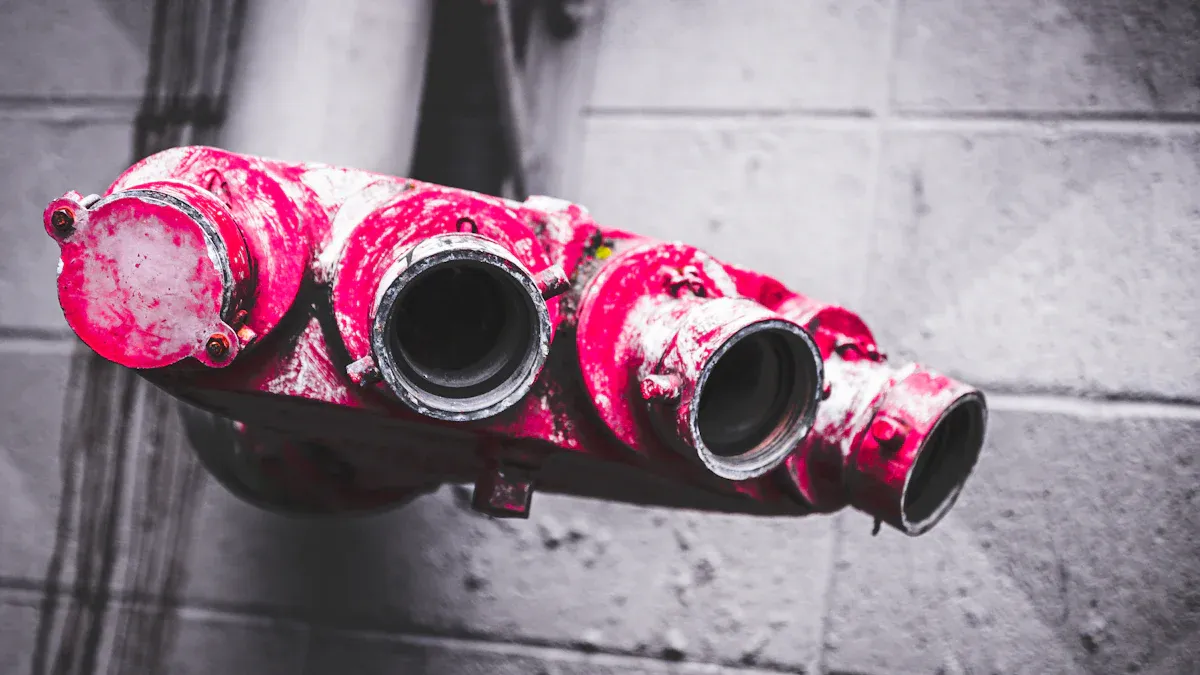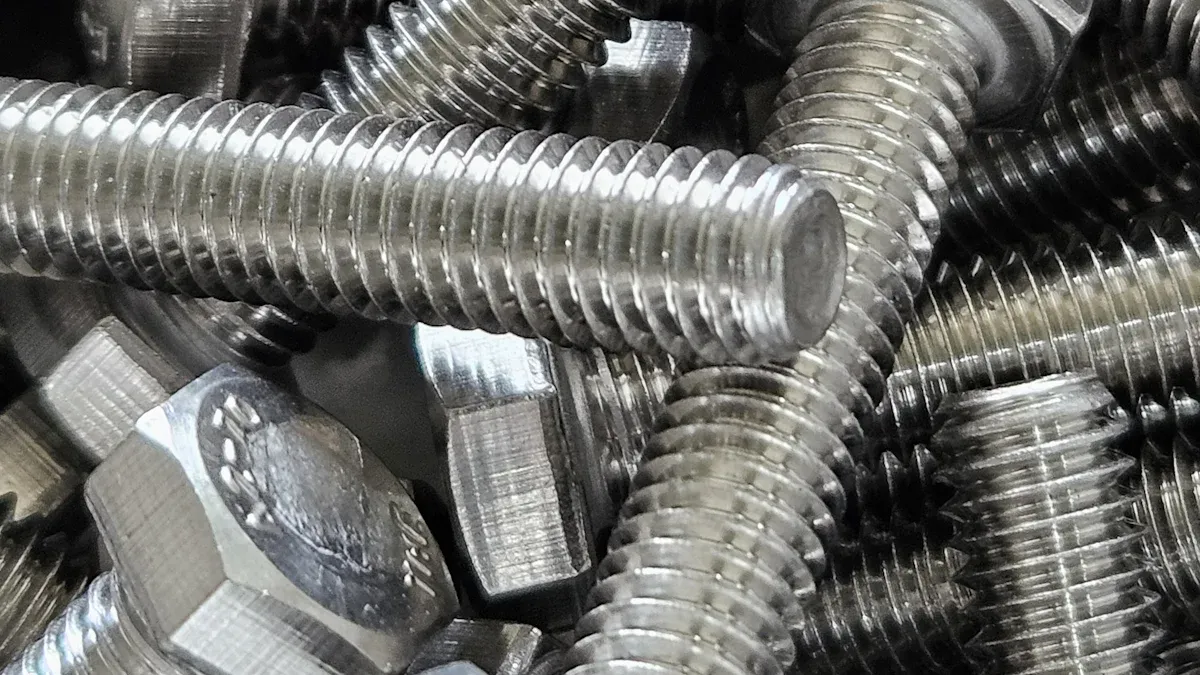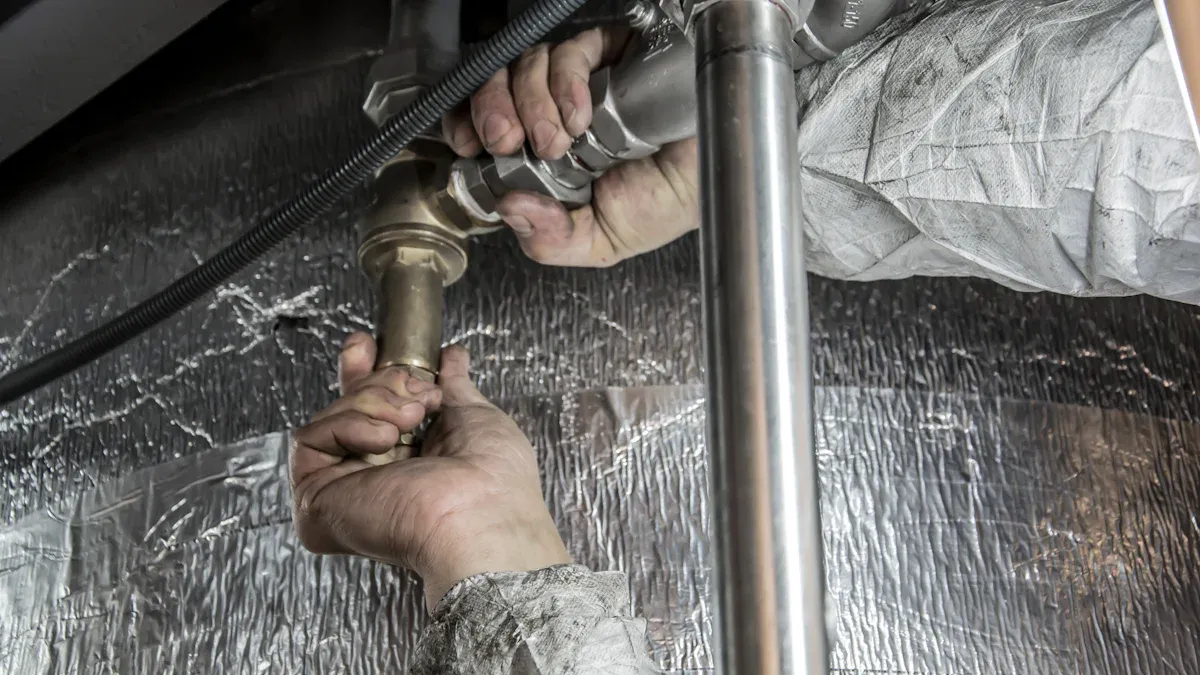
Stainless steel hose stems play a vital role in ensuring smooth operations across industries. Preventing wear on these components enhances their performance and reduces the risk of costly replacements. Proper maintenance not only extends their lifespan but also safeguards their structural integrity. For professionals relying on stainless steel swivel hose fittings, consistent care ensures reliability under demanding conditions. By prioritizing upkeep, users can enjoy durable stainless steel swivel fittings that meet their needs without fail. A proactive approach keeps these essential tools functioning at their best.
Key Takeaways
- Clean and check stainless steel hose stems often. This helps them last longer and stay in good shape.
- Look for early damage like color changes or scratches. Fixing these quickly saves time and money.
- Make a cleaning plan based on how often you use them. Clean daily, weekly, or monthly to keep them working well and avoid buildup.
- Handle and store hose stems carefully to avoid damage. Lift them instead of dragging, and keep them in a dry, neat place.
- Think about hiring experts for extra care. Professional help can make them stronger and stop expensive fixes.
Regular Cleaning and Inspection

Keeping stainless steel hose stems in optimal condition begins with regular cleaning and inspection. These practices not only maintain their appearance but also ensure their functionality over time. By dedicating time to proper care, users can prevent wear and extend the lifespan of these essential components.
Routine Cleaning Practices
Routine cleaning is the foundation of maintaining stainless steel hose stems. Following a structured approach ensures that dirt, grime, and contaminants do not compromise the material’s integrity. Here are some best practices:
- Use soap, mild detergent, or ammonia solutions mixed with warm water. Apply with a soft cloth or nylon sponge to gently clean the surface.
- For fresh stains, apply organic solvents like acetone or mineral spirits. Avoid chlorine-based solvents, as they can damage the stainless steel.
- For moderate soiling, use a mild abrasive cleaner with a soft cloth or nylon scouring pad. Always clean in long, even strokes that follow the direction of the finish.
- For heavier soiling, opt for ammonia solutions or warm detergents. Follow the same cleaning techniques as for moderate soiling.
- Consider a passivating treatment to enhance corrosion resistance. This involves thoroughly cleaning the surface and immersing it in a passivating acid bath.
These steps ensure that the stainless steel hose stem remains free from contaminants and retains its durability. Consistency in cleaning practices leads to better performance and fewer maintenance issues.
Early Signs of Wear
Identifying wear early can save time and money. Regular inspections help detect minor issues before they escalate into significant problems. Look for these common signs:
- Surface Discoloration: A dull or uneven finish may indicate contamination or corrosion.
- Scratches or Abrasions: Visible marks can weaken the material over time.
- Pitting or Rust Spots: These are early indicators of corrosion, often caused by exposure to harsh chemicals or improper cleaning methods.
- Loose Connections: Check for any wobbling or instability in the hose stem fittings.
By addressing these signs promptly, users can prevent further damage and ensure the stainless steel hose stem continues to perform reliably.
Tip: Keep a log of inspection findings. This helps track wear patterns and identify recurring issues that may require adjustments in handling or cleaning practices.
Cleaning Frequency Guidelines
Establishing a cleaning schedule is crucial for maintaining stainless steel hose stems. The frequency depends on the environment and usage conditions. Here are some general guidelines:
- Daily Cleaning: For hose stems used in environments with high exposure to contaminants, such as food processing or chemical industries.
- Weekly Cleaning: For moderate-use applications, such as general manufacturing or light industrial settings.
- Monthly Cleaning: For hose stems in low-risk environments, like storage or occasional-use scenarios.
Adjust the frequency based on the specific demands of your application. Regular cleaning prevents buildup and ensures the stainless steel hose stem remains in peak condition.
Note: Over-cleaning with harsh chemicals can cause unnecessary wear. Always use appropriate cleaning agents and tools to protect the material.
Proper Handling and Storage

Proper handling and storage play a crucial role in preserving the integrity of stainless steel hose stems. By adopting effective practices, users can prevent unnecessary wear and extend the lifespan of these essential components.
Safe Handling Techniques
Handling stainless steel hose stems with care minimizes the risk of physical damage. Professionals should follow these techniques to ensure safe usage:
- Lift Instead of Dragging: Always lift hose stems when moving them. Dragging can cause scratches or abrasions on the surface.
- Use Protective Gloves: Wearing gloves prevents oils and dirt from transferring to the stainless steel, reducing the risk of contamination.
- Avoid Excessive Force: When connecting or disconnecting fittings, apply steady pressure instead of forcing them. Excessive force can weaken connections over time.
- Inspect Before Use: Check for visible damage or loose fittings before operating the hose stem. Early detection prevents accidents and ensures smooth functionality.
Tip: Train staff on proper handling techniques to reduce the likelihood of mishandling and improve overall equipment care.
Storage Tips for Longevity
Storing stainless steel hose stems correctly ensures their durability and readiness for future use. Implementing these storage tips can help maintain their quality:
- Choose a Dry Location: Store hose stems in a dry area to prevent moisture buildup, which can lead to corrosion.
- Use Protective Covers: Cover hose stems with non-abrasive materials to shield them from dust and debris.
- Organize by Size and Type: Arrange hose stems systematically to avoid accidental damage during retrieval.
- Elevate Off the Ground: Use racks or shelves to keep hose stems off the floor, protecting them from dirt and potential impact.
Note: Regularly inspect stored hose stems to ensure they remain in good condition and are ready for use when needed.
Environmental Factors to Avoid
Certain environmental conditions can accelerate wear and damage to stainless steel hose stems. Avoiding these factors helps preserve their performance:
- High Humidity: Prolonged exposure to humid environments can cause corrosion. Use dehumidifiers in storage areas if necessary.
- Extreme Temperatures: Avoid storing hose stems in areas with fluctuating temperatures, as this can weaken the material over time.
- Chemical Exposure: Keep hose stems away from harsh chemicals that may cause discoloration or corrosion.
- Direct Sunlight: Prolonged exposure to sunlight can degrade protective coatings and affect the hose stem’s appearance.
Reminder: Conduct regular environmental assessments to ensure storage conditions remain optimal for stainless steel hose stems.
Avoiding Contamination and Damage
Preventing contamination and physical damage is essential for maintaining the performance and longevity of stainless steel hose stems. By understanding common risks and adopting protective measures, users can ensure these components remain reliable and efficient.
Common Contaminants to Watch For
Contaminants can compromise the integrity of stainless steel hose stems, leading to wear and reduced functionality. Some of the most common contaminants include nickel and chromium, which can leach into the material under certain conditions. The table below highlights their impact:
| Contaminant | Cooking Duration | Increase in Concentration | Average Leached per Serving |
|---|---|---|---|
| Nickel (Ni) | 6 hours | Up to 26-fold | 88 μg |
| Chromium (Cr) | 6 hours | Up to 7-fold | 86 μg |
| 10th cycle | 34-fold (Ni), 35-fold (Cr) | N/A |
These contaminants often result from prolonged exposure to harsh environments or improper cleaning agents. Monitoring and addressing contamination early can prevent long-term damage.
Tip: Use cleaning products specifically designed for stainless steel to minimize the risk of introducing harmful substances.
Preventing Cross-Contamination
Cross-contamination occurs when particles from one material transfer to another, potentially causing corrosion or weakening the stainless steel. To prevent this, designate separate tools and cleaning supplies for stainless steel components. Avoid using brushes or sponges that have been in contact with other metals. Additionally, rinse thoroughly after cleaning to remove any residual chemicals.
Reminder: Label cleaning tools to ensure they are used exclusively for stainless steel maintenance.
Protecting Against Physical Damage
Physical damage, such as scratches or dents, can weaken the structure of a stainless steel hose stem. To protect against this, handle components with care and avoid contact with abrasive surfaces. Use protective covers during transport or storage to shield them from impact. Regularly inspect for signs of damage, such as dents or loose fittings, and address issues promptly.
Callout: Investing in proper storage solutions, like padded racks or cases, can significantly reduce the risk of physical damage.
By taking these steps, users can safeguard their stainless steel hose stems from contamination and damage, ensuring optimal performance and durability.
Using Appropriate Tools and Cleansers
Selecting Safe Cleaning Products
Choosing the right cleaning products is essential for maintaining the integrity of stainless steel hose stems. Harsh chemicals can damage the surface, leading to premature wear. Opt for products specifically designed for stainless steel. These cleansers often contain mild ingredients that effectively remove dirt without causing harm.
Avoid chlorine-based cleaners, as they can corrode the material. Instead, use solutions with neutral pH levels. For everyday cleaning, a mixture of warm water and mild detergent works well. Organic solvents, such as acetone or mineral spirits, are excellent for tackling fresh stains. Always check the product label to ensure compatibility with stainless steel.
Tip: Test any new cleaning product on a small, inconspicuous area before applying it to the entire surface.
Tools to Prevent Scratches
The tools used during cleaning play a significant role in preventing scratches. Abrasive materials can leave marks that weaken the surface over time. Soft cloths, nylon sponges, and non-abrasive scouring pads are ideal for cleaning stainless steel hose stems.
When dealing with stubborn grime, avoid using steel wool or wire brushes. These tools can cause micro-scratches that may lead to corrosion. Instead, use plastic scrapers or soft-bristled brushes for tougher cleaning tasks. Always clean in the direction of the metal’s grain to maintain its polished appearance.
Reminder: Replace worn-out cleaning tools regularly to avoid accidental damage caused by frayed edges or embedded debris.
Removing Stubborn Residue Safely
Stubborn residue can be challenging to remove, but using the right methods ensures safety and effectiveness. Caustic soda (sodium hydroxide) is a powerful cleaning agent commonly used in industries like brewing. It effectively breaks down tough residues when applied correctly. However, users must handle it with care, wearing protective gloves and ensuring proper ventilation.
For less aggressive options, try soaking the hose stem in warm water mixed with a mild detergent. This loosens residue, making it easier to wipe away. For particularly tough spots, apply a paste made of baking soda and water. Let it sit for a few minutes before scrubbing gently with a nylon brush.
Callout: Always rinse thoroughly after using any cleaning agent to prevent residue buildup that could compromise the stainless steel’s performance.
By selecting safe products, using appropriate tools, and following proven methods, users can keep their stainless steel hose stems in pristine condition. These practices not only enhance durability but also ensure optimal performance over time.
Advanced Maintenance Techniques
Passivation Benefits
Passivation is a powerful technique that enhances the durability of stainless steel hose stems. This process creates a protective oxide layer on the surface, shielding the material from corrosion and wear. By removing contaminants and restoring the metal’s natural resistance, passivation ensures long-term performance.
The benefits of passivation are remarkable:
- Corrosion resistance improves by up to 40%, reducing the risk of damage in harsh environments.
- A water treatment facility reported a 90% decrease in corrosion-related incidents over three years after implementing advanced maintenance techniques.
- Enhanced surface preparation during passivation extended maintenance intervals by 18 months in an oil refinery project.
These results highlight the transformative impact of passivation. It not only protects the material but also reduces maintenance costs and downtime.
Tip: Regular passivation can significantly extend the lifespan of stainless steel components, making it a worthwhile investment.
Performing Passivation
Performing passivation requires precision and attention to detail. The process begins with thorough cleaning to remove dirt, grease, and other contaminants. Next, the stainless steel is treated with a passivating solution, typically containing nitric or citric acid. This solution dissolves impurities and forms a protective oxide layer.
After treatment, the component is rinsed with deionized water to remove any residual chemicals. Drying the surface completely is essential to prevent water spots or streaks. For best results, professionals recommend testing the surface to ensure the passivation process was successful.
Reminder: Always follow safety guidelines when handling passivating solutions. Wear protective gear and work in a well-ventilated area.
Professional Maintenance Options
For those seeking expert care, professional maintenance services offer tailored solutions for stainless steel hose stems. These services include advanced techniques like electrochemical cleaning, ultrasonic cleaning, and specialized passivation treatments. Professionals use state-of-the-art equipment to achieve optimal results, ensuring the components remain in peak condition.
Outsourcing maintenance can save time and effort while delivering superior outcomes. Experts can identify potential issues early, preventing costly repairs or replacements. Many industries, such as water treatment and oil refining, rely on professional services to maintain their equipment’s reliability and efficiency.
Callout: Partnering with experienced professionals ensures stainless steel hose stems receive the highest level of care, maximizing their performance and longevity.
Consistent care transforms stainless steel hose stems into long-lasting tools. Regular cleaning preserves their appearance and function, while inspections catch early signs of wear. Lubrication shields against erosion in challenging environments, and contamination prevention ensures reliability. These practices reduce downtime and extend the lifespan of components. By adopting these strategies, users protect their investment and enjoy optimal performance. Every effort contributes to durability, making maintenance a rewarding habit.
Reminder: Small actions today prevent costly repairs tomorrow. Start prioritizing care for stainless steel hose stems now.
FAQ
What is the best way to clean stainless steel hose stems?
Using warm water and mild detergent works best. Apply with a soft cloth or nylon sponge to avoid scratches. For tougher stains, use organic solvents like acetone. Always rinse thoroughly and dry completely to prevent water spots.
Tip: Clean in the direction of the metal’s grain for a polished finish.
How often should stainless steel hose stems be inspected?
Inspect hose stems regularly based on usage. For high-use environments, check weekly. In low-risk settings, monthly inspections suffice. Look for discoloration, scratches, or loose fittings to catch issues early.
Reminder: Keep a log of inspections to track wear patterns effectively.
Can improper storage damage stainless steel hose stems?
Yes, improper storage can cause corrosion or physical damage. Store in a dry, cool area away from chemicals and direct sunlight. Use protective covers and elevate the stems off the ground to prevent dirt and impact.
Callout: Organize hose stems by size and type to avoid accidental damage.
Why is passivation important for stainless steel?
Passivation enhances corrosion resistance by creating a protective oxide layer. This process removes contaminants and strengthens the material, extending its lifespan. Regular passivation reduces maintenance needs and ensures reliable performance.
Note: Professional passivation services deliver the best results for long-term durability.
What tools should be avoided when cleaning stainless steel?
Avoid abrasive tools like steel wool or wire brushes. These can scratch the surface and lead to corrosion. Instead, use soft cloths, nylon sponges, or plastic scrapers for safe cleaning.
Reminder: Replace worn-out tools to prevent accidental damage during cleaning.
Post time: Jun-10-2025
